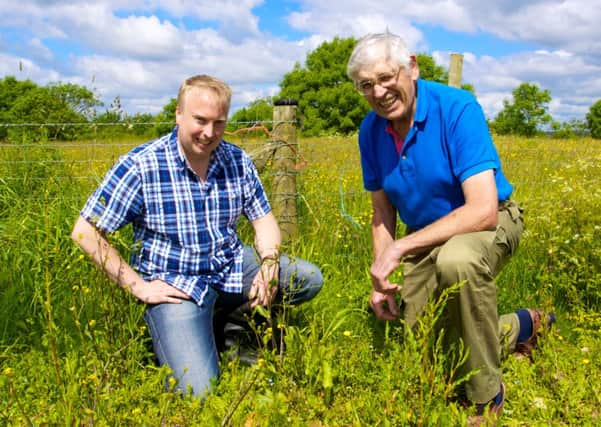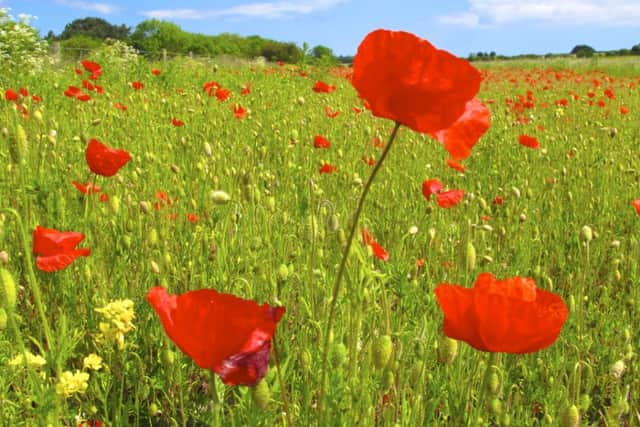And they call it poppy love


It is a flower more associated with battlefields than cornfields, but half a century ago swathes of poppies tapestried Britain’s farmland in summer.
Their apparent indestructibility was shown right along the Western Front in the First World War. Vast numbers of blood-red poppies continued to flourish between the trenches in the shell-cratered hell of no man’s land, at places like Flanders, the Somme and Passchendaele, and soon became associated with fallen soldiers.
Advertisement
Hide AdAdvertisement
Hide AdBack home, however, farmers took a less sentimental attitude towards the poppy. They saw it as nothing more than a weed which reduced the size of their crops, and dearly wished they could get rid of it.


Their prayers were answered by the drive to feed the growing population of baby boomers in the 1950s. The poppy may have survived the bloodiest conflict in history but was no match for a new generation of chemical herbicides. And so poppies and dozens of other plants which had brought pageants of colour to the British countryside each summer were finally eradicated.
Now, though, the deflowering of arable fields is being reversed by a dozen or so Yorkshire farmers taking part in a unique initiative run from a remote corner of the North York Moors National Park. The Cornfield Flowers Project is reviving species of flowers that were common on arable land before the advent of weedkillers, and is overseeing their reintroduction to a number of fields in North and East Yorkshire.
Many of the plants may be gone, but a couple of generations ago their names were familiar in country areas. Corncockle (Agrostemma githago), for example, is a dramatic pink flower which became virtually extinct in the wild but has been given a new lease of life in the project’s 25-acre show site near the hamlet of Silpho, not far from Scarborough.
Advertisement
Hide AdAdvertisement
Hide AdSimilarly, white campion (Silene latifolia) – known in the Yorkshire Wolds as “soldiers’ buttons” – was driven to the edges of arable crops but is now growing freely in the Silpho field.
Other plants found at Silpho have beautiful and intriguing names. Venus’s-looking-glass (Legousia hybrida) has a tiny, elusive pale blue flower, while the well-known but rarely seen scarlet pimpernel (Anagallis arvensis) lives up to its name of “poor man’s weatherglass” by only opening in bright light. One of the most striking of all is the cornflower (Centaurea cyanus), also known by country folk as “bluebottle” and said by the poet John Clare to “trouble the cornfield with its destroying beauty”.
This year, however, the flower everyone is asking the project to provide is the common poppy. “We’re getting a lot of interest just now because of the World War One centenary,” says Chris Wilson, a farmer who works as joint co-ordinator of the project. “Some people have asked us if we can provide poppies for commemorative services in November, but I had to tell them the flowers will all be dead by then. Poppies are at their best in summer.”
Although the common poppy (Papaver rhoeas) managed to survive in many field margins despite the advent of weedkillers, a related species known as the prickly poppy (Papaver argemone) went into steep decline. Its population has been revived by the project, however, and Chris is growing it in his greenhouse for seeds which will be given to farmers.
Advertisement
Hide AdAdvertisement
Hide AdThe project’s biggest success story has been rescuing from the brink of oblivion the red hemp-nettle (Galeopsis angustifolia), which has a short but highly visible pinkish-red flower. It is classed as “critically endangered”, one step up from total extinction in the wild, and appears on the international Red List of threatened species. A decade ago it was known to exist at just one place in the whole of North Yorkshire – just outside the village of Thornton-le-Dale – but botanists managed to get 13 seeds from the plant, and it is now growing successfully at several locations, including the Yorkshire Wildlife Trust reserve at Wharram Quarry, to the south-east of Malton, and at Nunburnholme, near Pocklington.
One of the participating farmers, Stephen Gibson, from Terrington in the Howardian Hills, found a new method of gathering the seeds. Usually, botanists would bend the plant sideways into a paper bag, give it a shake and collect ten if they were lucky. But Stephen came up with the idea of holding a biscuit tin next to the plant and giving it a whack with his hand. He got 100 in one go. There were so many, in fact, that the Yorkshire plants have stocked the National Trust’s Millennium Seed Bank, which is the world’s largest seed conservation project.
Says Chris: “As far as we are concerned now, that plant is completely safe in the wild, and not just in North Yorkshire.
Another notable success has been the corn buttercup (Ranunculus arvensis), also known in farming areas as “devil’s coachwheel”. A smaller relative of the familiar common buttercup, it is pale-lemon in colour and its leaves are divided into stalks. Like most flowers of arable land it was still common half a century ago but in the 1970s was thought to have completely vanished.
Advertisement
Hide AdAdvertisement
Hide AdIt was rediscovered in 1991 near the village of Faceby on the western side of the North York Moors, then disappeared again until found growing in a field of sugar beet at Kirkbymoorside.
Chris smiles at the memory. “We kidnapped that plant, then gave it a paper funnel and managed to persuade it to drop 32 seeds. Some of our volunteer growers put it in nurseries, where it began to sprout like gooseberry bushes. It now grows spontaneously in a dense yellow swathe at Silpho, and last year we probably had thousands of them there.”
The third rarity successfully reared by the project is the shepherd’s needle (Scandix pecten-veneris), which had declined by 70 per cent in the UK since the 1950s and was considered extinct in Yorkshire until found growing near Scarborough in 2003. It is now thriving at Silpho and a number of other sites.
Tom Normandale, the other Cornfield Project co-ordinator, says they are always looking for more farmers to take part in the scheme and gardeners, allotment holders and schools to act as volunteer growers.
Advertisement
Hide AdAdvertisement
Hide AdMost of those who are involved, he says, do it because they are enthusiastic about wildlife and plant conservation. “I think they take a real pride in looking after something that has declined so much and become rare.”
• The Cornfield Flowers Project is a partnership between the North York Moors National Park, Ryedale Folk Museum and the Carstairs Countryside Trust. Further details can be found at www.northyorkmoors.org.uk/caring/our-work/cornfield-flowers-project
A Harvest of Colour: Saving Cornfield Flowers in North East Yorkshire by Ian Carstairs is available from North York Moors National Park visitor centres, priced at £7.99.